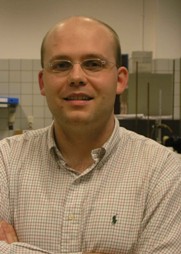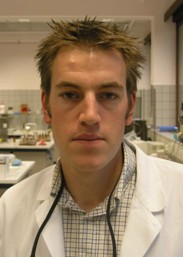Org. Synth. 2007, 84, 215
DOI: 10.15227/orgsyn.084.0215
SELECTIVE Pd-CATALYZED AMINATIONS ON CHLORO-IODOPYRIDINES: SYNTHESIS OF ETHYL 4-[(6-CHLOROPYRIDIN-3-YL)AMINO]BENZOATE
Submitted by Geert Rombouts
1, Bert U.W. Maes
1, Tim H.M. Jonckers
2, and Kristof T.J. Loones
1.
Checked by Praew Thansandote
3 and Mark Lautens
3.
1. Procedure
Ethyl 4-[(6-chloropyridin-3-yl)amino]benzoate. To a 250-mL, one-necked, round-bottomed flask, fitted with a septum pierced with nitrogen inlet and outlet needles, is added Pd(OAc)2 (0.135 g, 0.6 mmol) (Note 1), rac. BINAP (0.374 g, 0.6 mmol) (Note 2) and 100 mL of toluene (Note 3). The mixture is stirred under a nitrogen flow for 15 min. In a 1000 mL round-bottomed, three-necked flask is added 2-chloro-5-iodopyridine (7.183 g, 30 mmol) (Note 4), ethyl 4-aminobenzoate (5.947 g, 36 mmol) (Note 5) and Cs2CO3 (48.873 g, 150 mmol) (Note 6). Then, a reflux condenser equipped with a bubbler filled with oil is placed on the three-necked flask and one of the side necks is stoppered. Subsequently, a nitrogen inlet is connected to the remaining neck and the apparatus is flushed with nitrogen for 5 min. Next, under a low flow of nitrogen, the stoppered side neck is opened and the catalyst solution is added through a funnel using 200 mL of toluene (Note 3) to rinse the flask. Under magnetic stirring the resulting mixture is flushed with nitrogen for 10 min. Then, the nitrogen inlet is removed, the neck stoppered and the 1000 mL, three-necked flask placed in a preheated oil bath at 130 °C for 20 h under a nitrogen atmosphere (Note 7). Vigorous magnetic stirring is required to prevent precipitation of the base (Note 8). When the reaction mixture is cooled down to room temperature, it is filtered over a sintered glass filter funnel containing Celite® (Note 9) using 1000 mL of EtOAc (Note 10). The filtrate is concentrated at reduced pressure by rotary evaporation at 45 °C (75 mmHg) to afford a brown oil. The residue is dissolved in a minimal amount of 99:1 CH2Cl2:MeOH (Notes 11 and 12) and loaded on a pre-packed silica gel column (40 × 6 cm, ± 500 g) (Notes 13 and 14). The 99:1 CH2Cl2:MeOH eluent is used to isolate ethyl 4-[(6-chloropyridin-3-yl)amino]benzoate, in addition to fractions mixed with ethyl-4-aminobenzoate (Note 15). The impure fractions are collected and concentrated at reduced pressure by rotary evaporation at 45 °C (75 mmHg). The resulting dark beige crystals are then dissolved in a minimum amount of dichloromethane (Note 11) and loaded onto a second pre-packed silica gel column (40 × 6 cm, ± 500 g) (Notes 13 and 14). Pure dichloromethane (Note 11) is used as an eluent until the product begins to elute and subsequently, 99:1 CH2Cl2:MeOH is used to afford ethyl 4-[(6-chloropyridin-3-yl)amino]benzoate (7.068 g combined from two purifications, 25.5 mmol, 85%) (Notes 16–20) as a light beige solid.
2. Notes
1.
Palladium(II)acetate (47.5 % Pd) was used as received from Acros.
2.
(rac)-2,2'-Bis(diphenylphosphino)-1,1'-binaphtyl (98%) was used as received from Acros.
3.
Toluene (for analysis, ACS) was used as received from Acros.
4.
2-Chloro-5-iodopyridine (98+%) was used as received from Alfa Aesar. The submitters used this compound as received from Acros.
5.
Ethyl 4-aminobenzoate (98%) was used as received from Acros.
6.
Cesium carbonate (99.5%) was used as received from Acros for the first trial, and cesium carbonate (99.9%) from Aldrich was used as received for the second trial. No difference in the reactions was observed when using the different sources. Since a large excess (5 equiv) of both bases (Acros and Aldrich) were used and the reaction was only checked after 20 hours at reflux, no differences in conversion between both bases were expected.
7.
The checkers used an argon atmosphere with no change in the results of the procedure.
8.
In a
500-mL round-bottomed, three-necked flask, a magnetic stirring rate of 700 rpm was used; for the
1000-mL round-bottomed, three-necked flask, the stirring rate was 1000 rpm.
9.
A
sintered glass filter funnel with a volume of 350 mL, a diameter of 9 cm and a pore size of 0.010–0.016 mm was used. The funnel was filled with Celite® to a height of 6 cm.
10.
Ethyl acetate (min. 99%) was used as received from VWR Scientific.
11.
Dichloromethane (99.9%) was used as received from VWR Scientific. The submitters used dichloromethane (technical) from Caldic, which was distilled before use.
12.
MeOH (99+%) was used as received from Acros.
13.
Silica gel (0.040–0.063 mm, pore diameter ca 6 nm) from Silicycle was used. The submitters used silica gel (0.035–0.070 mm, pore diameter approximately 6 nm) from Acros.
14.
The pre-packed silica gel column was made by using a slurry of silica gel and the eluent.
15.
At this stage, 62% of pure ethyl 4-[(6-chloropyridin-3-yl)amino]benzoate was isolated. Chromatography was performed at ambient pressure to ensure good separation.
16.
Before calculating the yield, the reaction product was dried under vacuum (0.5 mmHg) for 20 h.
17.
The R
f value of ethyl 4-[(6-chloropyridin-3-yl)amino]benzoate in 94:6 CH
2Cl
2:MeOH was 0.67. The submitters reported an R
f value of 0.16 using TLC plates Alugram(r) Sil G/UV
254 from Marcherey-Nagel). Hence, the submitters used this solvent system as a starting eluent for column chromatography, and finished with 92:8 CH
2Cl
2:MeOH once the product began to elute. See Notes
11 and
12 for solvent quality and
Note 13 for silica type. The R
f of ethyl 4-[(6-chloropyridin-3-yl)amino]benzoate in 99:1 CH
2Cl
2:MeOH was 0.31. Thin layer chromatography (TLC) by the checkers was conducted using plates cut from 20 × 20 cm TLC aluminum sheets (Silica gel 60 F
254 from Merck). See Notes
11 and
12 for solvent quality and
Note 13 for silica type.
18.
Ethyl 4-[(6-chloropyridin-3-yl)amino]benzoate:
1H NMR
pdf (CDCl
3) δ: 1.38 (t,
J = 7.4 Hz, 3 H, CH
3), 4.35 (q,
J = 7.6 Hz, 2 H, CH
2), 6.12 (br s, 1 H, NH), 6.99 (d,
J = 8.8 Hz, 2 H, H-2',6'), 7.27 (d,
J = 8.0 Hz, 1 H, H-3), 7.50 (dd,
J = 8.4 Hz, 2.4 Hz, 1 H, H-4), 7.96 (d,
J = 8.4 Hz, 2 H, H-3',5'), 8.24 (d,
J = 3.2 Hz, 1 H, H-6);
13C NMR
pdf (CDCl
3) δ: 14.4; 60.7, 115.3, 123.1, 124.5, 129.3, 131.6, 137.0, 141.2, 144.2, 146.3, 166.2; HRMS (ESI) for C
14H
14ClN
2O
2 [M+H
+] found: 277.0738, calcd: 277.0744; Calcd for C
14H
13ClN
2O
2: C, 60.85; H, 4.75; Cl: 12.67; N, 10.14; O, 11.59. Found: C, 60.72; H, 4.81; N, 10.0.
19.
Elemental analyses were recorded for the checkers on a 2400 Series II CHNS Analyzer. Elemental analysis was recorded for the submitters in the “Hungarian Academy of Sciences” on a Vario EL III (CNHS) (project: GVOP-3.2.1–2004–04–0311/3.0).
20.
The procedure as reported enabled the recovery of starting material (ethyl 4-aminobenzoate). Alternatively, the submitters suggested the following procedure to remove residual aniline prior to purification:
Derivatization of the excess aniline to the corresponding acetamide was required in some cases to simplify the purification of the desired reaction product from the excess of aniline. The need for derivatization depended on the chloro-iodopyridine substrate and the specific aniline used. For the synthesis of ethyl 4-[(2-chloropyridin-3-yl)amino]benzoate, derivatization of the excess aniline was used to separate the reaction product from ethyl 4-aminobenzoate. Acetamide formation through the reaction of 4-aminobenzoate with acetyl chloride in refluxing CH
2Cl
2 with triethylamine as base was used to effect derivative formation.
Handling and Disposal of Hazardous Chemicals
The procedures in this article are intended for use only by persons with prior training in experimental organic chemistry. All hazardous materials should be handled using the standard procedures for work with chemicals described in references such as "Prudent Practices in the Laboratory" (The National Academies Press, Washington, D.C., 2011 www.nap.edu). All chemical waste should be disposed of in accordance with local regulations. For general guidelines for the management of chemical waste, see Chapter 8 of Prudent Practices.
These procedures must be conducted at one's own risk. Organic Syntheses, Inc., its Editors, and its Board of Directors do not warrant or guarantee the safety of individuals using these procedures and hereby disclaim any liability for any injuries or damages claimed to have resulted from or related in any way to the procedures herein.
3. Discussion
The procedure described above is a typical example of the Pd-catalyzed C-5 arylamination of 2-chloro-5-iodopyridine.
4 The observed selectivity is due to chemoselective oxidative addition on the substrate. The weak non-nucleophilic base used in this protocol is essential to obtain broad functional group compatibility.
5 For instance, the traditionally-used MO
tBu, which is often employed as the base in Buchwald-Hartwig reactions, is incompatible with the presence of an ester group. If weak bases are used in Buchwald-Hartwig reactions, rate-limiting deprotonation of the Pd(II)-amine intermediate formed in the catalytic cycle is most likely and consequently often observed. Interestingly, the use of a large excess of weak base, although mostly insoluble in the standard solvents used (tetrahydrofuran, dioxane and toluene),
5 speeds up the reactions in those cases.
6 In 2004, our laboratory gained experimental evidence that this remarkable “
base effect” is due to an interphase deprotonation mechanism of the Pd(II)-amine intermediate formed.
6 Vigorous magnetic stirring of the reaction mixture is, in these cases, essential in order to keep the specific surface area of the base maximal. Interestingly, hitherto there are no other straightforward methods known to allow access to
N-aryl-2-chloropyridin-5-amines. The selective Buchwald-Hartwig protocol on 2-chloro-5-iodopyridine can also be extended to other chloro-iodopyridines such as 2-chloro-3-iodopyridine, as was recently shown by us and scientists from Merck.
4,6,7
Appendix
Chemical Abstracts Nomenclature (Collective Index Number);
(Registry Number)
Palladium(II) acetate:
Acetic acid, palladium(2+) salt: (3375-31-3)
rac. BINAP:
Phosphine, [1,1'-binaphthalene]-2,2'-diylbis[diphenyl-; (98327-87-8)
2-Chloro-5-iodopyridine; (69045-79-0)
Ethyl 4-aminobenzoate; (94-09-7)
Cesium Carbonate:
Carbonic acid, dicesium salt; (534-17-8)
 |
Bert Maes was born in Sint-Niklaas, Belgium and obtained his Ph.D. in Organic Chemistry in 2001 from the University of Antwerp for his work on new synthetic strategies for the functionalization of the pyridazine nucleus. In October 2001 he was appointed Post-Doctoral Fellow from the Fund for Scientific Research - Flanders (FWO-Vlaanderen). At the University of Antwerp he started his independent research career in the division of Organic Chemistry. In February 2003 he was appointed Professor of Organic Chemistry in the Department of Chemistry of the University of Antwerp. His scientific interests include heterocyclic, organometallic and microwave-assisted chemistry.
|
 |
Geert Rombouts was born in 1978 in Borgerhout, Belgium. He followed a Professional Bachelor in Chemistry Education program at the Karel de Grote Hogeschool in Antwerp. For his bachelor thesis he chose the division of Organic Chemistry of the University of Antwerp. After graduation in 2002, he remained in the research group of Professor Maes to work on various academic and industrial projects during which he expanded his skills to a broad range of experimental techniques in different areas of organic chemistry including MAOS, organometallic chemistry and cross-coupling reactions.
|
 |
Tim Jonckers was born in Antwerp in 1974. He studied Chemistry at the University of Antwerp and obtained his Ph.D. in organic chemistry in 2002. His Ph.D. work covered the synthesis of new necryptolepine derivatives which have potential antimalarial activity. Currently he works as a Senior Scientist at Tibotec, a pharmaceutical research and development company based in Mechelen, Belgium, that focuses on viral diseases mainly AIDS and hepatitis. The company was acquired by Johnson & Johnson in April 2002 and recently gained FDA approval for its HIV-protease inhibitor PREZISTA(tm).
|
 |
Kristof Loones was born in Antwerp, Belgium in 1979. In 2001 he obtained his M.Sc. degree in Chemistry from the University of Antwerp. Currently he is a PhD student in the division of Organic Chemistry of the University of Antwerp. His PhD study focuses on the use of the Buchwald-Hartwig reaction in heterocyclic chemistry, in particular he studies tandem metal catalyzed inter- and intramolecular aminations on 2,3-dihaloheterocycles and the accelerating effect of microwave heating.
|
 |
Praew Thansandote was born in Khon Kaen, Thailand in 1983. She received a Bachelor of Science (B.Sc. Hons) degree in Biopharmaceutical Sciences with top honors at the University of Ottawa in 2001. Following undergraduate research with Mark Workentin at the University of Western Ontario and Keith Fagnou at the University of Ottawa, she is currently a Ph.D. candidate with Mark Lautens at the University of Toronto developing new palladium-catalysed multicomponent reactions. Her awards include a University of Ottawa Medal for the Faculty of Science, a Pfizer Undergraduate Research Fellowship, and NSERC Canada Graduate Scholarships at the Master and Doctoral levels.
|
Copyright © 1921-, Organic Syntheses, Inc. All Rights Reserved